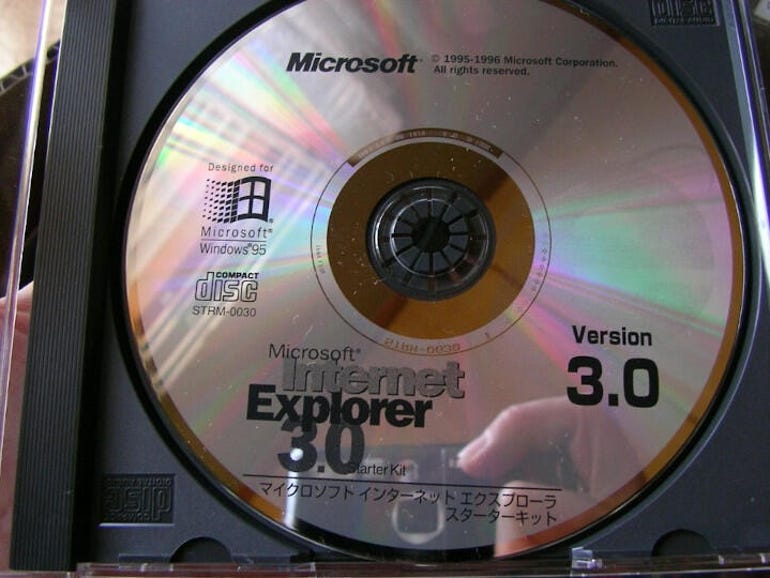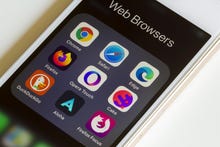- Your iPad is getting a major upgrade for free. 4 top features I can't wait to try in iPadOS 26
- Your MacBook is getting a big upgrade. 5 best features I can't wait to use in MacOS 26
- The Growing Threat of AI-powered Cyberattacks in 2025
- I test tablets for a living and this is the Samsung tablet I recommend the most
- The Cost of Ignoring Patches: How State and Local Governments Can Mitigate Damaging Security Breaches
How Internet Explorer really beat Netscape | ZDNet

Microsoft
In 1994, I’d already been covering the internet for years and I knew it was going to change the world. Microsoft still hadn’t come around to that idea. In the first edition of Bill Gates’s book The Road Ahead, he barely mentions the internet. In the next edition, Gates gave the internet a chapter to itself and by May 1995 he realized that the internet would be a technology tidal wave. Microsoft started rewriting history to make itself an internet pioneer. Recently, Hadi Partovi, CEO of Code.org, revived that tired narrative in a series of tweets in which he claimed Internet Explorer “was the first real salvo in the ‘Browser Wars.’“
I covered the web in those days and I beg to disagree.
While Microsoft’s top brass put the internet on the back burner, others realized that Microsoft needed something to offer the numerous users who wanted a web browser. Their quick-fix solution was to adopt a commercial version, Spyglass, of the first widely successful web browser, Mosaic. This was the foundation of Internet Explorer (IE) 1, which rolled out the doors on August 16, 1995, as part of Microsoft Plus for Windows 95, a Windows software add-on package.
IE 1 did not do well. It also left a bad taste in Spyglass’s mouth. Spyglass was to receive a percentage of Microsoft’s profits from IE. What actually happened was Microsoft began bundling IE with Windows starting with the next version of Windows 95 for OEMs. Microsoft would eventually settle with Spyglass for $8 million in 1987.
This Spyglass/Mosaic codebase would remain part of IE until IE 7 was released. The About window on IE 1 to IE 6 all contained the text “Distributed under a licensing agreement with Spyglass, Inc.”
In the meantime, Marc Andreessen, one of Mosaic’s creators, took the Mosaic code and turned it into the first widely successful web browser, Netscape. Andreessen boasted that Netscape would “reduce Windows to a set of poorly debugged device drivers.”
Microsoft returned the “love.” Netscape CEO James Barksdale testified that in a meeting with Microsoft: “I had never been in a meeting in my 33-year business career in which a competitor had so blatantly implied that we should either stop competing with it or the competitor would kill us.”
Partovi says Microsoft did this with technology, not illegal deals. Still, he admits that “we signed partnerships with anybody who would help us, even competitors like Apple and AOL.” At the time, though, Apple was in financial hot water and was even allowing other companies to build Mac clones, e.g. DayStar Digital. America Online (AOL) was trying to jump from being a modem-based online service to a destination website and Internet Service Provider (ISP). Neither were Microsoft rivals. But, they could bring IE to more customers.
He claimed that the Internet Explorer team was “the hardest-working team I’ve ever been on. And I’ve worked at multiple start-ups. It was a sprint, not a marathon. We ate every meal at the office. We often held foosball tournaments at 2 am, just to get the team energy back up to continue working!”
Partovi added, “Sadly, there were divorces and broken families and bad things that came out of that. But I also learned that even at a 20,000-person company, you can get a team of 100 people to work like their lives depend on it.”
He says this as if it were a good thing. It wasn’t. The rise of IE and the fall of Netscape had little to do with all programming death marches and everything to do with Microsoft’s monopoly over the desktop.
Since then, Partovi has backed off this last claim. He’s since admitted he “created the misimpression of a toxic culture and then glorified it.” He also confessed that when he founded Code.org, it “started out in an unsustainable ‘crunch mode,’ and as we’ve grown, we’ve intentionally focused on how to achieve our ambitious long-term goals in a way that also offers a healthy work/life balance for our team.”
In his initial tweets he credits IE 3 for starting IE’s run to web browser market share victory. “When IE3 launched 25 years ago, it didn’t win the browser war, but it made a serious dent, and Netscape began to worry. Two years later we shipped IE5, which became the dominant web browser of its time.”
Why? Partovi continues: “Tech history explains this to be about Microsoft’s Windows monopoly, which surely played a role. But it wouldn’t have been possible if Microsoft didn’t also learn how to work on ‘Internet time.'”
Sorry, I reviewed all those versions of IE and their competition back in the day. I’m sure the IE team worked really hard on its program, but Netscape Communicator was where the real innovation happened. For example, love it or hate it, JavaScript is arguably the most popular language in the world, and JavaScript was a Netscape creation.
Here’s the real reason why IE beat Netscape: Microsoft strong-armed PC vendors into putting the new operating system and its browser on all their PCs. The goal was not so much to kill off other PC operating system vendors. There wasn’t any real competition in the mid-90s. The goal was to destroy Netscape.
The courts, in case you’ve forgotten, agreed. The Department of Justice won in its lawsuit against Microsoft on the grounds that its PC monopoly may make it impossible for Netscape to compete with IE. Unfortunately, rather than breaking Microsoft up into separate companies or open-sourcing Microsoft’s code, the government gave Microsoft a slap on the wrist.
As former judge Robert Bork, speaking on behalf of trade group ProComp, said at the time, the settlement was “indeed deeply harmful to the public interest” and “is completely deficient.” He described it as “a surrender” on the part of the Justice Department.
And, worse still, the deal failed to address one of the most important aspects of the court ruling that found Microsoft had violated U.S. antitrust law: The commingling code. In its decision, the court found that Microsoft’s merging together of the IE and Windows software code constituted an anticompetitive act. “Yet this decree does not deal with it at all…so Microsoft remains free to bolt products together,” Bork stated.
So, of course, Microsoft continued to do this. Netscape staggered on to eventually die. Years later, its browser code would live on in the Firefox web browser.
For more than a decade, Microsoft would continue to dominate both the desktop and the browser. It was only after Google, a technology business powerhouse in its own right, released the Chrome web browser in 2008 that IE would face a market challenge it couldn’t overcome.
Technically, from beginning to end, IE was never the best browser. It won because an illegal monopoly was allowed to continue.
Related Stories:


